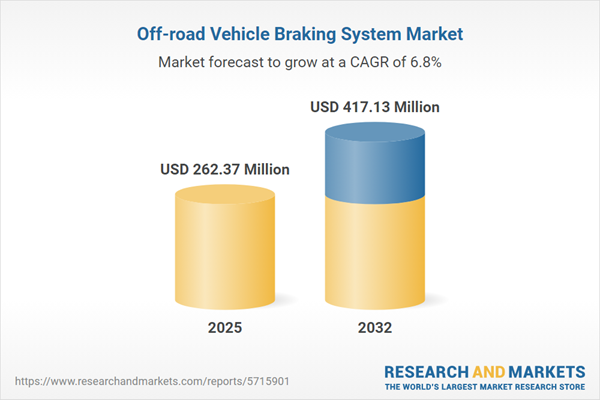Speak directly to the analyst to clarify any post sales queries you may have.
The off-road vehicle braking system market is undergoing significant transformation, presenting senior decision-makers with new operational challenges and opportunities as regulations tighten and technology evolves. Effective alignment between innovation and compliance is crucial for organizations striving to maintain competitiveness and agility in this sector.
Market Snapshot: Off-Road Vehicle Braking System Market Overview
The off-road vehicle braking system market is defined by robust growth, in step with technical advances in safety and development of higher compound annual growth rates. Demand is shaped by priorities for reliable, high-performance braking, with electronic brake solutions making significant inroads across diverse applications. Manufacturers are dedicating increased resources to research and innovation, targeting systems built to withstand severe, unpredictable off-road environments. As regulatory frameworks grow more complex, market participants capable of integrating compliance-driven and forward-thinking product design are establishing new standards for operational excellence and differentiation.
Scope & Segmentation: Comprehensive Market Structure
- Vehicle Types: Includes All-Terrain Vehicles, Dirt Bikes, Side-By-Side Vehicles, and Utility Vehicles serving recreational, industrial, and commercial needs, each presenting unique requirements for durability and system configuration.
- Brake Types: Disc Brakes, recognized for adaptable caliper designs; Drum Brakes, preferred for steady, reliable performance; and Electric Brakes, tailored to integrate with advanced chassis and control infrastructure for specialized results.
- Sales Channels: Involves direct relationships with Original Equipment Manufacturers for seamless system integration, as well as robust aftermarket networks vital for ongoing product upgrading and lifecycle support.
- Material Types: Ceramic, Organic, and Semi-Metallic options, each selected and engineered for optimal resilience under intense thermal or mechanical stress to extend product life and manage heat effectively.
- Applications: Includes sectors such as Agriculture, Mining, Construction, Military, Racing, and Recreation, where tailored solutions are essential for regulatory adherence and meeting sector-specific functional requirements.
- Regions: The Americas, Europe, Middle East & Africa, and Asia-Pacific; each region demonstrates distinctive technology uptake and faces regulatory influences that drive local adaptation strategies for manufacturers and suppliers.
- Key Companies: Prominent players shaping industry benchmarks include Robert Bosch GmbH, Continental AG, ZF Friedrichshafen AG, Brembo S.p.A., Akebono Brake Industry Co. Ltd., Knorr-Bremse AG, Meritor Inc., Mando Corporation, Nissin Kogyo Co. Ltd., and Advics Co. Ltd.
Key Takeaways for Senior Decision-Makers
- Leveraging ongoing investments in hydraulic, electric, and electronic braking technology is crucial to ensuring steady enhancements in both reliability and performance adaptability for off-road operations.
- Responsive adoption of modular system designs and flexible manufacturing infrastructure facilitates rapid compliance with evolving regulatory landscapes while supporting operational risk control.
- Strengthened collaboration across the supply chain streamlines adaptation to new customer specifications and accelerates the delivery of market-ready product enhancements.
- Integration of lightweight and sensor-enabled braking components boosts early maintenance detection, optimizes asset longevity, and supports consistent regulatory conformance.
- Expansion in the aftermarket segment empowers manufacturers to fulfill an increasing array of niche customer needs, providing industry-specific solutions for evolving market gaps.
Impact of United States Tariffs on Off-Road Vehicle Braking System Supply Chains
Recent United States tariffs have significantly altered sourcing and production strategies within the off-road vehicle braking system supply chain. Manufacturers are responding by reinforcing domestic manufacturing capacity and engaging closely with local or regional suppliers. This shift not only increases compliance with regulatory mandates but also enhances control over inventory and mitigates risks from global disruptions, helping organizations ensure greater continuity in business operations.
Methodology & Data Sources
This analysis draws from recognized industry research partners, evaluated regulatory standards, and direct input from engineering and supply chain experts. All findings are peer-reviewed and curated to ensure applicability and value for senior executives and strategic planners operating in the off-road vehicle braking system market.
Why This Report Matters
- Provides a structured benchmarking framework for manufacturers to identify progress and recalibrate strategies in response to evolving market and regulatory shifts.
- Details effective pathways for modular and advanced sensor-driven brake system adoption, guiding organizations towards optimized investment and enhanced operational resilience.
- Clarifies key transformative factors—including technology advances and shifting risk profiles—empowering leadership with actionable information for strategic decision-making.
Conclusion
A proactive approach combining technology-driven innovation, adaptive supply chain management, and ongoing regulatory compliance is vital for sustained performance and growth in the evolving off-road vehicle braking system sector.
Additional Product Information:
- Purchase of this report includes 1 year online access with quarterly updates.
- This report can be updated on request. Please contact our Customer Experience team using the Ask a Question widget on our website.
Table of Contents
3. Executive Summary
4. Market Overview
7. Cumulative Impact of Artificial Intelligence 2025
Companies Mentioned
The companies profiled in this Off-road Vehicle Braking System market report include:- Robert Bosch GmbH
- Continental AG
- ZF Friedrichshafen AG
- Brembo S.p.A.
- Akebono Brake Industry Co., Ltd.
- Knorr-Bremse AG
- Meritor, Inc.
- Mando Corporation
- Nissin Kogyo Co., Ltd.
- Advics Co., Ltd.
Table Information
| Report Attribute | Details |
|---|---|
| No. of Pages | 190 |
| Published | October 2025 |
| Forecast Period | 2025 - 2032 |
| Estimated Market Value ( USD | $ 262.37 Million |
| Forecasted Market Value ( USD | $ 417.13 Million |
| Compound Annual Growth Rate | 6.8% |
| Regions Covered | Global |
| No. of Companies Mentioned | 11 |









